Evaluation of Street Lighting Efficiency Using a Mobile Measurement System
Abstract
:1. Introduction
2. Road Lighting Standard EN 13201
- CEN/TR 13201-1:2014—Road lighting—Part 1: Guidelines on selection of lighting, 2014;
- EN 13201-2:2015—Road lighting—Part 2: Performance requirements, 2015;
- EN 13201-3:2015—Road lighting—Part 3: Calculation of performance, 2015;
- EN 13201-4:2015—Road lighting—Part 4: Methods of measuring lighting performance, 2015;
- EN 13201-5:2015—Road lighting—Part 5: Energy performance indicators, 2015.
- DP—power density index [W ∗ lx−1 ∗ m−2],
- —mean horizontal illumination intensity in subarea i [lx],
- Pi—power of the lighting installation is used to illuminate the respective areas i [W],
- Ai—area of the subarea illuminated by the lighting installation [m2],
- n—number of illuminated areas.
- P—total power of the lighting installation [W],
- Pk—power of the k-th lighting point [W],
- Pad—total power of devices is not included in Pk but required for the functioning of the road installation [W],
- nip—number of lighting points connected to the installation or the presented od-cut depending on the application during the calculation.
- (a)
- The technology and light sources used.
- (b)
- The total time the lighting installation is switched on.
- (c)
- The lighting class achieved, as defined in the relevant lighting standard for each lighting period.
- (d)
- The efficiency of the lighting installation in providing the necessary illumination levels for each period.
- (e)
- The way the lighting management system follows the evolution of the visual needs of road users.
- (f)
- The parasitic energy consumption of lighting equipment during periods when lighting is not needed.
- (a)
- Seasonal variations in the proportion of daytime and nighttime hours: this mainly depends on the geographical location of the illuminated area.
- (b)
- Varying weather conditions which affect the perceived visual efficiency (e.g., dry or wet road surface).
- (c)
- Varying traffic volumes on a street or in a public area at night (i.e., different time patterns of use, e.g., increased use during “night-time” peak hours or fluctuations in the social activity of residents (e.g., school periods, public holidays).
- (d)
- A change in the functionality of a street or public area (e.g., roads are closed for a certain period of time or turned into pedestrian areas during holiday periods).
- DE—annual energy consumption rate for road lighting installation [Wh ∗ m−2],
- Pj—operational power associated with the jth operating period [W],
- tj—duration of the jth operating period when Pj is consumed during the year [h],
- A—area of the area illuminated by the same lighting system [m2],
- m—number of periods with different power of installation Pj; the idle period of power supply (partial energy consumption) is also taken into account.
- (a)
- The formal normative requirements—the lighting class used [38].
- (b)
- Types of light sources used and luminaire designs.
- (c)
- Geometry and cross-section of the road.
- (d)
- Applied system of setting poles and luminaires of road lighting.
- (e)
- Reflective class of the road surface.
- (f)
- The schedule of luminaire power reduction implemented.
- (g)
- The control system (adaptive or fixed).
- (h)
- Operation and maintenance procedures adopted.
- (a)
- The total power of the lighting system P (W), the power of all elements related to the illuminated area (individual area i), and necessary for the functioning of the applied lighting system. For the calculation, the following must be taken into account: lamp power, ballasts, control devices, lighting controllers, etc. If the calculation takes an elementary area of the road section between two consecutive luminaires located on one side of the carriageway, identical to the calculation area, only the power of one of the luminaires (or half of the power of the two luminaires) has to be taken into account. If the energy performance calculation is carried out along the whole length of a road, or a section of it longer than one photometric calculation field, all luminaires related to this section of road shall be taken into account.
- (b)
- Illuminated area (m2): In general, this may be the same elementary area as the calculation field or it may be the whole length of the lighting installation—in the case of straight road sections. The indicators are also applicable to any area of regular or irregular shape such as squares, parks, pedestrian zones, etc.
- (c)
- The parameter of the average illuminance value in the area under consideration . The illuminance parameter must be expressed in lx for all classes. For classes C and P, the average horizontal illuminance is taken and for class M, the area illuminance constant calculated according to EN 13201-3 at the same calculation points as those where the luminance value was determined is taken. Currently available calculation programs provide luminance and illuminance values for the same calculation grid. Therefore, there is no limitation to convert illuminance to luminance at the design stage.
Measurement of Lighting Parameters
- (a)
- (b)
- The overall uniformity of roadway illuminance Uo. The uniformity of the illuminance should be calculated as the ratio of the lowest illuminance at each point in the calculation or measurement field to the average illuminance.
- (a)
- In the longitudinal direction:where:
- D—distance between points in the longitudinal direction [m]
- S—distance between luminaires [m]
- N—number of design points in the longitudinal direction:
- For S ≤ 30 m, N = 10;
- For S ≥ 30 m, the smallest integer gives D ≤ 3 m.
- (b)
- In the transverse direction:where:
- d—distance between design points in the transverse direction [m]
- Wr—width of the roadway or surface under consideration [m].
- n—number of points in the transversal direction equal to 3 or more and being an integer d ≤ 1.5 m.
3. Materials and Methods
3.1. Mobile Measurement System Concept
3.2. Description of the Measurement Field
4. Results
4.1. Empirical measurements
4.2. Selection of a Typical Representative Section
4.3. Stationary Measurements on a Representative Section
4.4. Results
5. Discussion
6. Conclusions
- -
- The lighting installations in operation vary significantly depending on the road geometry and terrain. Therefore, the whole road route cannot always be treated as a repeatable geometric system.
- -
- -
- Illumination measurement can be disturbed by lanterns from neighboring streets or traffic lights; placing the sensor on the roof of the car partially eliminates this problem.
- -
- It is necessary to continue research work on converting the measurement planes for different geometries of lighting installations (e.g., from 1.5 m to 0.0 m).
- -
- It is possible to measure lighting parameters and calculate energy indices both for the entire road system and for individual measurement sections, which is important from the point of view of selecting places where the assumed levels were not achieved.
- -
- It is possible to measure the illuminance level of the road while the vehicle is driving. Such measurements significantly accelerate the assessment of the state of illumination and determination of lighting class in accordance with the standard and allow to indicate the sections of underexposed or overexposed.
- -
- Obtained results of illuminance may be the basis for determining the average value of illuminance in a given area of the illuminated road.
- -
- Creation and sharing by infrastructure managers of geodetic data of lighting installations along with the power of installed luminaires (GIS) allows for quick identification of the power of luminaires installed in different sections of the road.
- -
- Based on the acquired data, it is possible to develop lighting maps and maps of energy indicators for entire roads or areas.
Author Contributions
Funding
Conflicts of Interest
References
- Bullough, J.D.; Donnell, E.T.; Rea, M.S. To Illuminate or Not to Illuminate: Roadway Lighting as it Affects Traffic Safety at Intersections. Accid. Anal. Prev. 2013, 53, 65–77. [Google Scholar] [CrossRef]
- Yannis, G.; Kondyli, A.; Mitzalis, N. Effect of Lighting on Frequency and Severity of Road Accidents. Proc. Inst. Civ. Eng.-Transp. 2013, 166, 271–281. [Google Scholar] [CrossRef]
- Jackett, M.; Consulting, J.; Frith, W. How Does the Level of Road Lighting Affect Crashes in New Zealand–A Pilot Study; Opus International Consultants: Lower Hutt, New Zealand, 2012. [Google Scholar]
- Kotulski, L. Smart Lighting–Nowe Spojrzenie na Oświetlenie Uliczne ... Systemy Dynamicznego Oświetlenia ulic–Przykład Rozwiązań Smart City. Available online: https://docplayer.pl/192892698-Smart-ligh-ng-nowe-spojrzenie-na-oswietlenie-uliczne-systemy-dynamicznego-oswietlenia-ulic-przyklad-rozwiazan-smart-city.html (accessed on 12 May 2021).
- Zissis, G.; Bertoldi, P.; Serrenho, T. Update on the Status of LED-Lighting World Market Since 2018; Publications Office of the European Union: Luxembourg, 2021; ISBN 978-92-76-27244-1. [Google Scholar]
- Traverso, M.; Donatello, S.; Moons, H.; Rodriguez Quintero, R.; Gama Caldas, M.; Wolf, O.; Van Tichelen, P.; Van Hoof, V.; Geerken, T. Revision of the EU Green Public Procurement Criteria for Street Lighting and Traffic Signals-Preliminary Report; Final Version EUR 28622 EN; Publications Office of the European Union: Luxembourg, 2017; ISBN 9789279690976. [Google Scholar]
- Quintero, R.R.; Garrido, C.V.-A.; Moons, H.; Caldas, M.G.; Wolf, O.; Skinner, I.; Van Grinsven, A.; ‘t Hoen, M.; van Essen, H. Revision of the EU Green Public Procurement Criteria for Transport; Publications Office of the European Union: Luxembourg, 2019; Volume 32, ISBN 9789279469640. [Google Scholar]
- EC Commission Regulation (EC) No 245/2009. Of 18 March 2009 Implementing Directive 2005/32/EC of the European Parliament and of the Council with Regard to Ecodesign Requirements for Fluorescent Lamps without Integrated Ballast, for High Intensity Discharge La. Off. J. Eur. Union 2009, 65, 60–87. [Google Scholar]
- EC Commission Regulation (EC) No 357/2010. Of 23 April 2010 Amending Regulation (EU) No 185/2010 of 4 March 2010 Laying Down Detailed Measures for the Implementation of the Common Basic Standards on Aviation Security. Off. J. Eur. Union 2010, 72, 10–11. [Google Scholar]
- Parliament, T.H.E.E.; Council, T.H.E.; The, O.F.; Union, E. Directive 2011/83/EU of the European Parliament and of the Council. Off. J. Eur. Union 2011, 8, 260–284. [Google Scholar]
- Oświetlenie Uliczne-Sektor Efektywności Energetycznej. Dobre Praktyki PPP. Available online: https://www.ppp.gov.pl/dobre-praktyki/ (accessed on 12 May 2021).
- EN 13201-5:2015-Road Lighting-Part 5: Energy Performance Indicators. 2015. Available online: https://infostore.saiglobal.com/preview/is/en/2015/i.s.en13201-5-2015.pdf?sku=1843914 (accessed on 12 May 2021).
- Ernst, S.; Kotulski, L.; Lerch, T.; Rad, M.; Sȩdziwy, A.; Wojnicki, I. Calculating Reactive Power Compensation for Large-Scale Street Lighting. Int. Conf. Comput. Sci. 2020, 12138, 538–550. [Google Scholar] [CrossRef]
- Pracki, P.; Wiśniewski, A.; Czyżewski, D.; Krupiński, R.; Skarżyński, K.; Wesołowski, M.; Czaplicki, A. Strategies Influencing Energy Efficiency of Lighting Solutions. Bull. Polish Acad. Sci. Tech. Sci. 2020, 68, 711–719. [Google Scholar] [CrossRef]
- Doulos, L.T.; Sioutis, I.; Kontaxis, P.; Zissis, G.; Faidas, K. A Decision Support System for Assessment of Street Lighting Tenders Based on Energy Performance Indicators and Environmental Criteria: Overview, Methodology and Case Study. Sustain. Cities Soc. 2019, 51, 101759. [Google Scholar] [CrossRef]
- Culver, S. Energy Efficiency in Ironing. Text. Rent. 2009, 92, 46–47. [Google Scholar]
- Light Naturally. Energy Efficiency Performance Requirements for Road Lighting Designs and Luminaires. Available online: https://www.energyrating.gov.au/sites/default/files/documents/StreetlightEEreport2014FINAL_0.pdf (accessed on 12 May 2021).
- Sȩdziwy, A.; Kotulski, L. Towards Highly Energy-Efficient Roadway Lighting. Energies 2016, 9, 263. [Google Scholar] [CrossRef]
- Wojnicki, I.; Kotulski, L. Improving Control Efficiency of Dynamic Street Lighting by Utilizing the Dual Graph Grammar Concept. Energies 2018, 11, 402. [Google Scholar] [CrossRef] [Green Version]
- Wojnicki, I.; Kotulski, L.; Sędziwy, A.; Ernst, S. Application of Distributed Graph Transformations to Automated Generation of Control Patterns for Intelligent Lighting Systems. J. Comput. Sci. 2017, 23, 20–30. [Google Scholar] [CrossRef]
- Jägerbrand, A.K. Synergies and Trade-Offs Between Sustainable Development and Energy Performance of Exterior Lighting. Energies 2020, 13, 2245. [Google Scholar] [CrossRef]
- Klaassen, N.; Scheepens, A.; Flipsen, B.; Vogtlander, J. Eco-Efficient Value Creation of Residential Street Lighting Systems by Simultaneously Analysing the Value, the Costs and the Eco-Costs during the Design and Engineering Phase. Energies 2020, 13, 3351. [Google Scholar] [CrossRef]
- Hermoso-Orzáez, M.J.; Lozano-Miralles, J.A.; Lopez-Garcia, R.; Brito, P. Environmental Criteria for Assessing the Competitiveness of Public Tenders with the Replacement of Large-Scale LEDs in the Outdoor Lighting of Cities as a Key Element for Sustainable Development: Case Study Applied with PROMETHEE methodology. Sustainability 2019, 11, 5982. [Google Scholar] [CrossRef] [Green Version]
- Doulos, L.; Tsangrassoulis, A.; Topalis, F.V. Multi-Criteria Decision Analysis To Select The Optimum Position and Proper Field of View of a Photosensor. Energy Convers. Manag. 2014, 86, 1069–1077. [Google Scholar] [CrossRef]
- Benito, B.; Guillamón, M.D.; Martínez-Córdoba, P.J. Determinants of Efficiency Improvement in the Spanish Public Lighting Sector. Util. Policy 2020, 64, 101026. [Google Scholar] [CrossRef]
- Lobão, J.A.; Devezas, T.; Catalão, J.P.S. Energy Efficiency of Lighting Installations: Software Application and Experimental Validation. Energy Rep. 2015, 1, 110–115. [Google Scholar] [CrossRef] [Green Version]
- Jägerbrand, A.K. LED (Light-Emitting Diode) Road Lighting in Practice: An Evaluation of Compliance with Regulations and Improvements for Further Energy Savings. Energies 2016, 9, 357. [Google Scholar] [CrossRef] [Green Version]
- Lipnicky, L.; Gasparovsky, D.; Dubnicka, R. Influence of the Calculation Grid Density to the Selected Photometric Parameters for Road Lighting. In Proceedings of the 2016 IEEE Lighting Conference of the Visegrad Countries (Lumen V4), Karpacz, Poland, 13–16 September 2016; pp. 1–4. [Google Scholar] [CrossRef]
- Leśko, M.; Różowicz, A.; Wachta, H.; Różowicz, S. Adaptive Luminaire with Variable Luminous Intensity Distribution. Energies 2020, 13, 721. [Google Scholar] [CrossRef] [Green Version]
- Martirano, L.; Ruvio, A.; Manganelli, M.; Lettina, F.; Venditti, A.; Zori, G. High Efficiency Lighting Systems with advanced Controls. IEEE Trans. Ind. Appl. 2021. [Google Scholar] [CrossRef]
- Maksimainen, M.; Vaaja, M.T.; Kurkela, M.; Virtanen, J.P.; Julin, A.; Jaalama, K.; Hyyppä, H. Nighttime Mobile Laser Scanning and 3D Luminance Measurement: Verifying the Outcome of Roadside Tree Pruning with Mobile Measurement of the road Environment. ISPRS Int. J. Geo-Inf. 2020, 9, 455. [Google Scholar] [CrossRef]
- Boyce, P.R. Light, lighting and human health. Light. Res. Technol. 2021. [Google Scholar] [CrossRef]
- Kyuchukov, T. Light Pollution-’Borders’ of Lighting Design. In Proceedings of the 2019 Second Balkan Junior Conference on Lighting (Balkan Light Junior), Plovdiv, Bulgaria, 19–21 September 2019; pp. 1–5. [Google Scholar] [CrossRef]
- Lim, H.S.; Ngarambe, J.; Kim, J.T.; Kim, G. The Reality of Light Pollution: A Field Survey for the Determination of Lighting Environmental Management Zones in South Korea. Sustainability 2018, 10, 374. [Google Scholar] [CrossRef] [Green Version]
- Jägerbrand, A.K. Effects of LED lighting on Animals and in the Natural Environment and Recommendations to Minimize the Impact. In Proceedings of the 8th Professional Lighting Design Convention, Rotterdam, The Netherlands, 23–26 October 2019; pp. 98–99. [Google Scholar]
- McNaughton, E.J.; Beggs, J.R.; Gaston, K.J.; Jones, D.N.; Stanley, M.C. Retrofitting Streetlights with LEDs has Limited Impacts on Urban Wildlife. Biol. Conserv. 2021, 254, 108944. [Google Scholar] [CrossRef]
- Commission Internationale de L’éclairage. Lighting of Roads for Motor and Pedestrian Traffic; International Commission on Illumination: Vienna, Austria, 2010; pp. 1–8. [Google Scholar]
- CEN/TR 13201-1:2014—Road lighting—Part 1: Guidelines on Selection of Lighting. 2014. Available online: https://standards.iteh.ai/catalog/standards/cen/69d92ac3-b17c-4208-bb2b-fab9175bb2a4/cen-tr-13201-1-2014 (accessed on 12 May 2021).
- EN 13201-2:2015-Road lighting—Part 2: Performance Requirements. 2015. Available online: https://standards.iteh.ai/catalog/standards/cen/af4239ad-70ec-48d2-bf4c-fba1a373d3ba/en-13201-2-2015 (accessed on 12 May 2021).
- EN 13201-3:2015-Road lighting—Part 3: Calculation of Performance. 2015. Available online: https://standards.iteh.ai/catalog/standards/cen/3b3f153c-192f-486e-ba81-d0a6dbb114c4/en-13201-3-2015 (accessed on 12 May 2021).
- EN 13201-4:2015-Road lighting—Part 4: Methods of Measuring Lighting Performance. 2015. Available online: https://standards.iteh.ai/catalog/standards/cen/7f260a69-7e63-4bdd-9282-39f4cc21a815/en-13201-4-2015 (accessed on 12 May 2021).
- Jes, M.; Gago-calder, A. Energy Efficiency and Sustainable Lighting-a Bet for the Future; IntechOpen: London, UK, 2020; ISBN 9781789859591. [Google Scholar]
- Sánchez Sutil, F.; Cano-Ortega, A. Smart Public Lighting Control and Measurement System Using Lora Network. Electronics 2020, 9, 124. [Google Scholar] [CrossRef] [Green Version]
- Torzewicz, T.; Baran, K.; Raszkowski, T.; Samson, A.; Wachta, H.; Napieralski, A. Compact Thermal Modelling of Power LED Light Sources. In Proceedings of the 2017 IEEE 30th International Conference on Microelectronics (MIEL), Nis, Serbia, 9–11 October 2017; pp. 157–160. [Google Scholar] [CrossRef]
- Baran, K.; Rózowicz, A.; Wachta, H.; Rózowicz, S. Modeling of selected lighting parameters of LED panel. Energies 2020, 13, 3583. [Google Scholar] [CrossRef]
- Zimmer, R.A. A mobile illumination evaluation system. Transp. Res. Rec. J. Transp. Res. Board 1988, 68–73. Available online: http://onlinepubs.trb.org/Onlinepubs/trr/1988/1172/1172-008.pdf (accessed on 12 May 2021).
- Johnson, M.; Fabregas, A.; Wang, Z.; Katkoori, S.; Lin, P.S. Embedded system design of an advanced illumination measurement system for highways. In Proceedings of the 2014 IEEE International Systems Conference Proceedings, Ottawa, ON, Canada, 31 March–3 April 2014; pp. 579–586. [Google Scholar] [CrossRef]
- Gibbons, R.B.; Meyer, J. Development of a Mobile Measurement System for Roadway Lighting. 2018. Available online: https://vtechworks.lib.vt.edu/bitstream/handle/10919/81535/NSTSCE_RLMMS_Final.pdf?sequence=1#:~:text=This%20system%2C%20the%20Roadway%20Lighting,and%20mounted%20on%20any%20vehicle.&text=The%20system%20also%20uses%20two,color%20camera%20for%20scene%20evaluation. (accessed on 12 May 2021).
- Zhou, H.; Pirinccioglu, F.; Hsu, P. A new Roadway Lighting Measurement System. Transp. Res. Part C Emerg. Technol. 2009, 17, 274–284. [Google Scholar] [CrossRef]
- Zhou, H.; Hsu, P.; Lin, P. A New Method to Evaluate Roadway Lighting Systems and Its Safety Effects. In Proceedings of the ITE 2010 Annual Meeting and Exhibit, Vancouver, Canada, 8–11 August 2010; p. AB10H283. [Google Scholar]
- QGIS A Free and Open Source Geographic Information System. Available online: https://www.qgis.org/en/site/ (accessed on 12 May 2021).
- Commission Staff Working Documen Commission Staff Working Document Eu Gpp Green Public Procurement Criteria for Road Lighting and Traffic Signals. Available online: https://ec.europa.eu/environment/gpp/pdf/toolkit/181210_EU_GPP_criteria_road_lighting.pdf (accessed on 12 May 2021).
- Rychlicki, M.; Kasprzyk, Z.; Rosiński, A. Analysis of Accuracy and Reliability of Different Types of GPS Receivers. Sensors 2020, 20, 6498. [Google Scholar] [CrossRef] [PubMed]
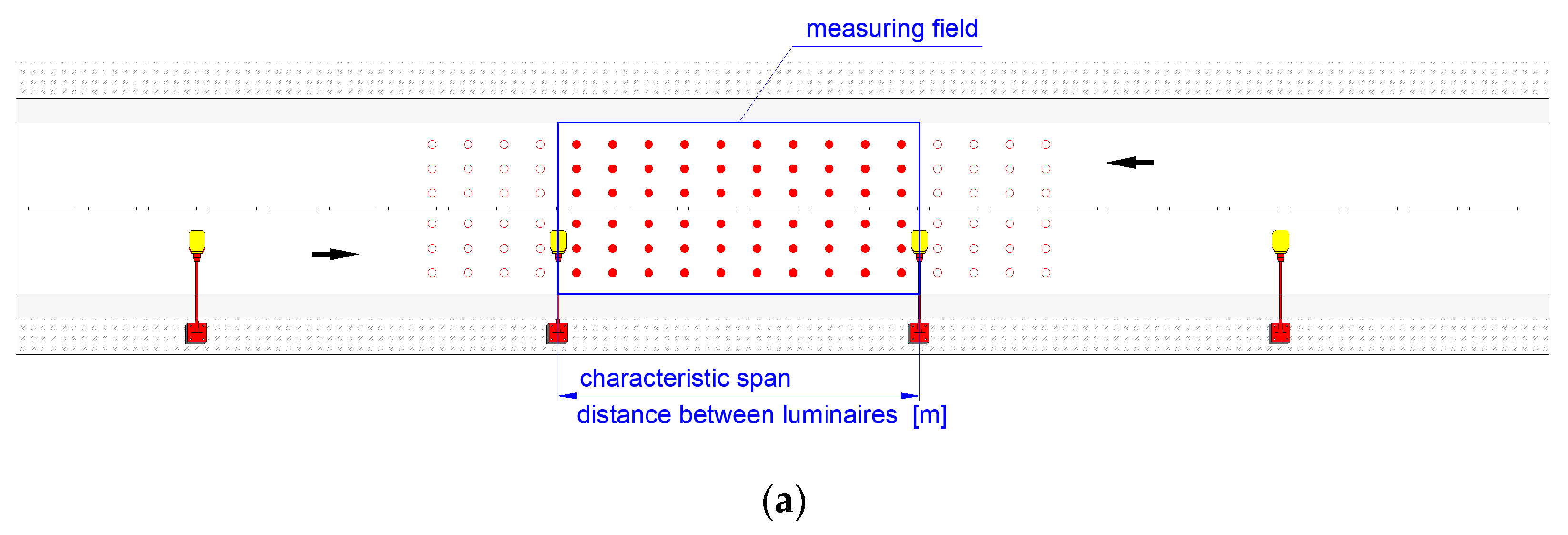
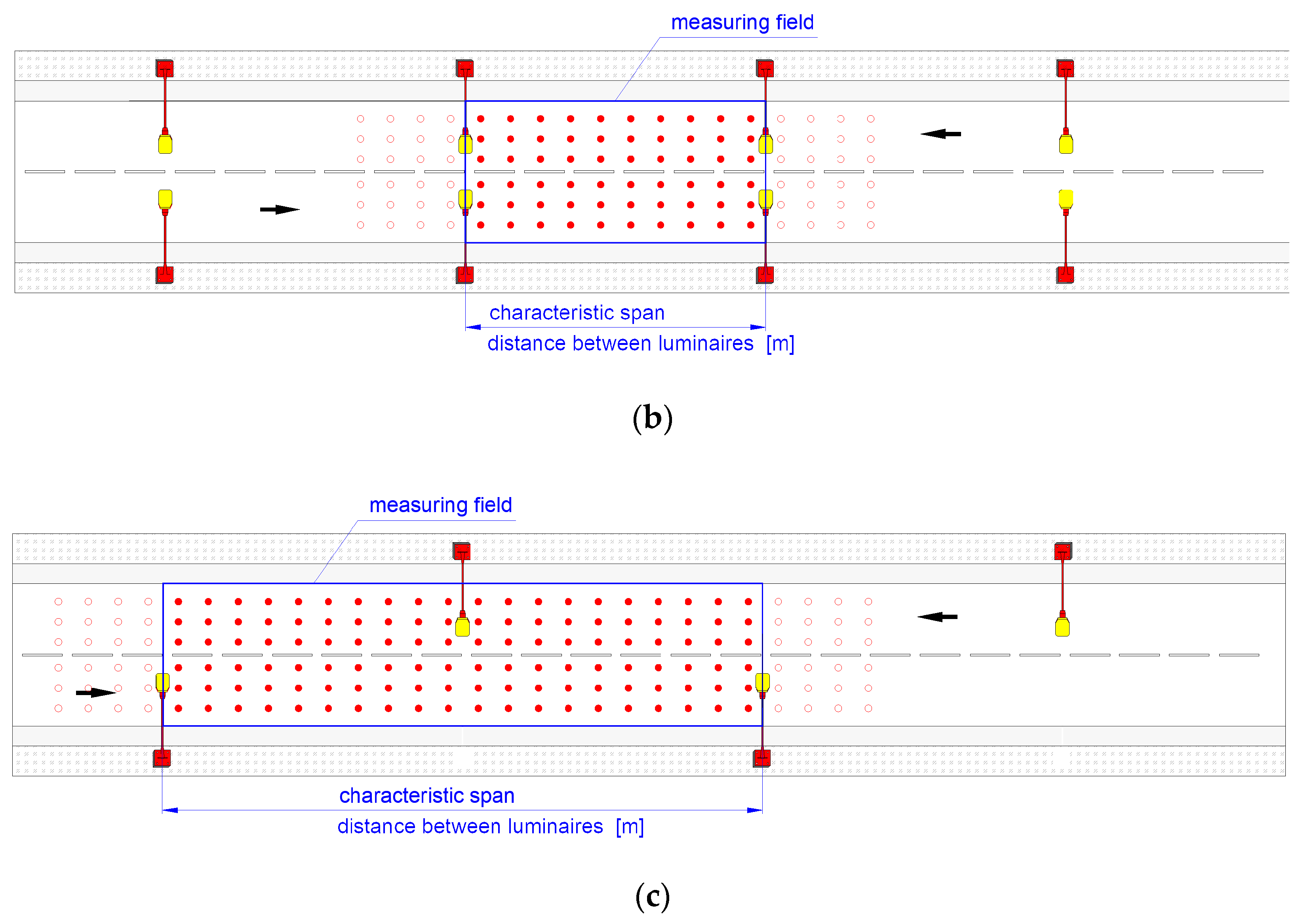
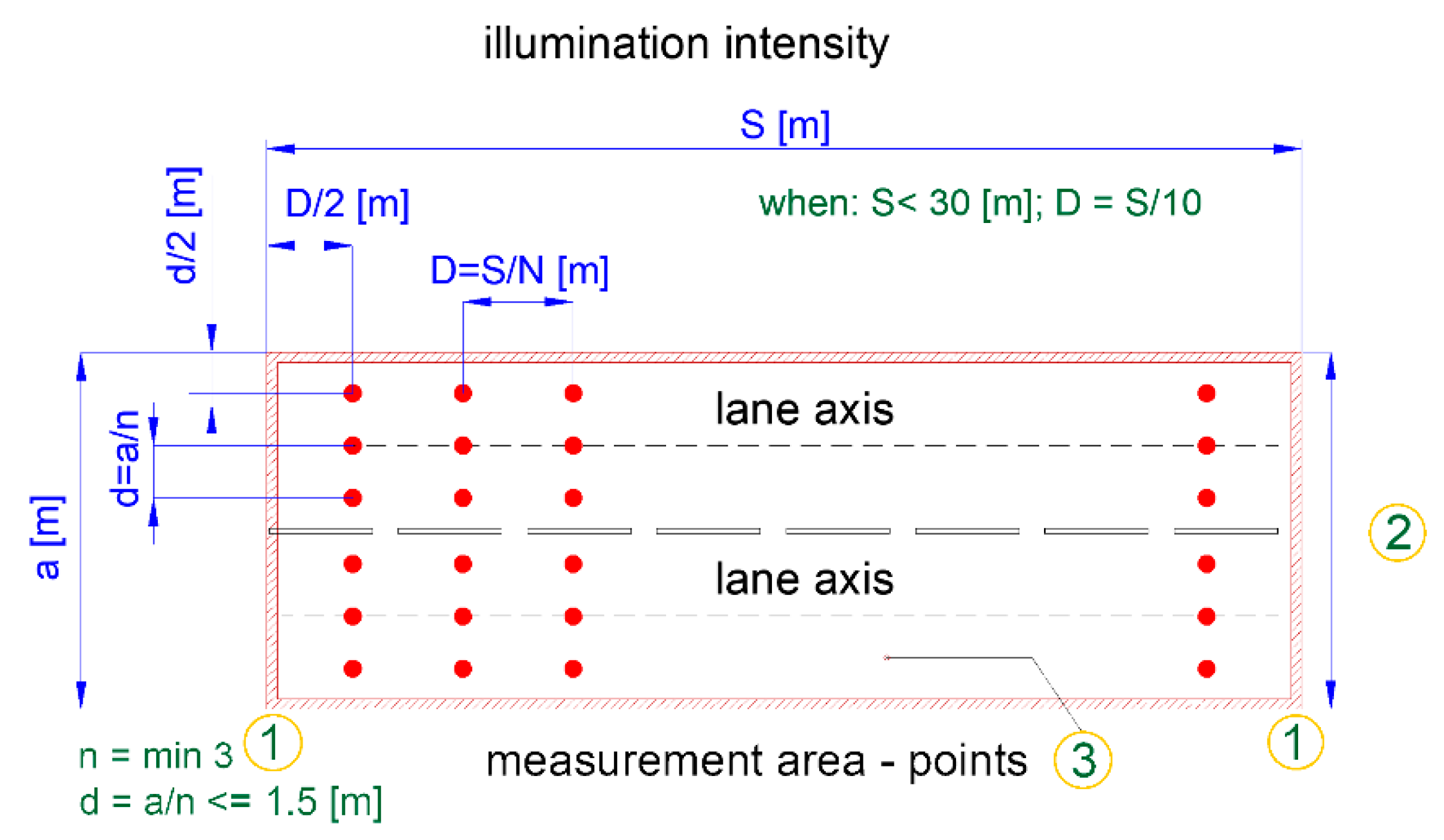

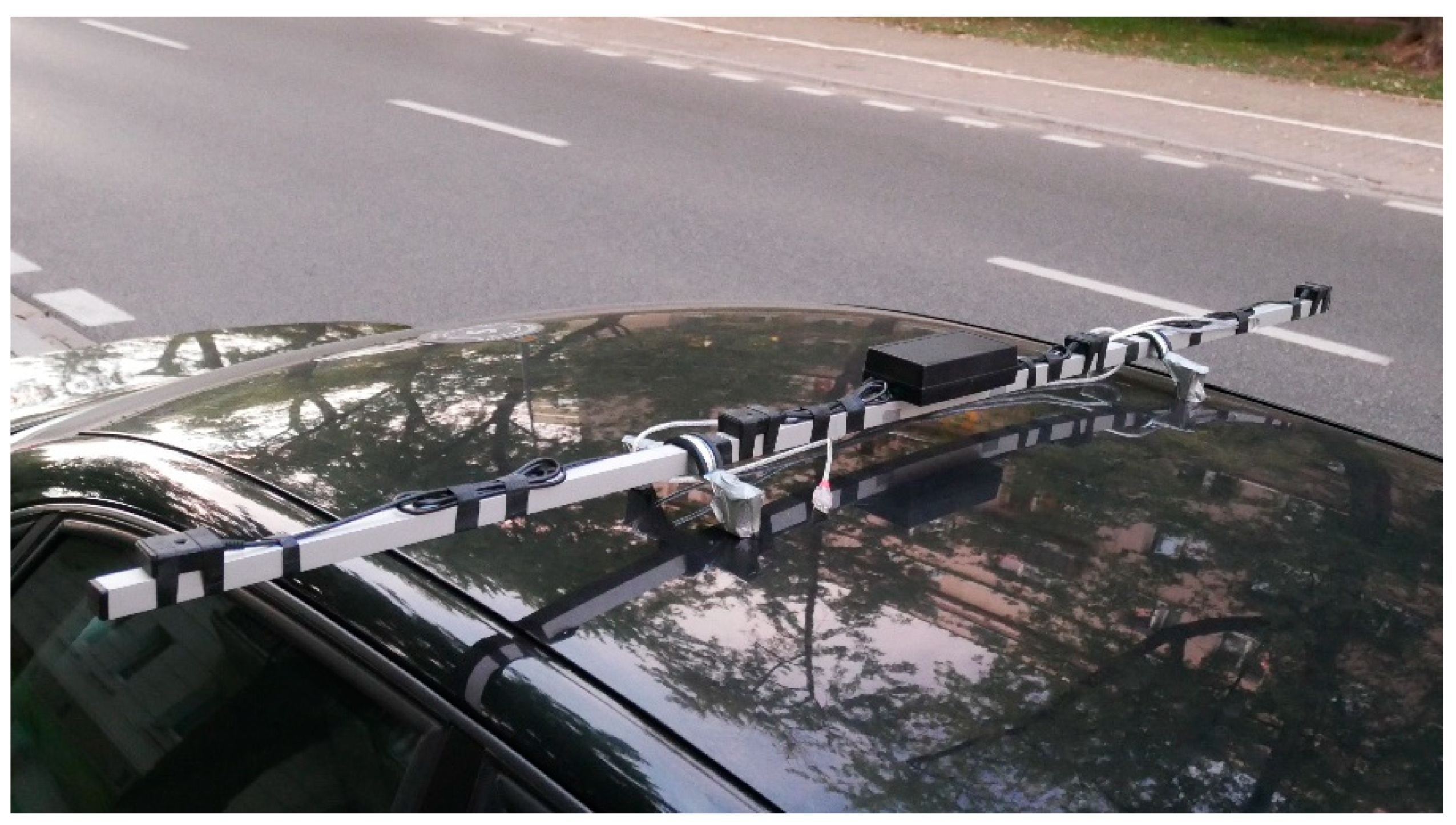
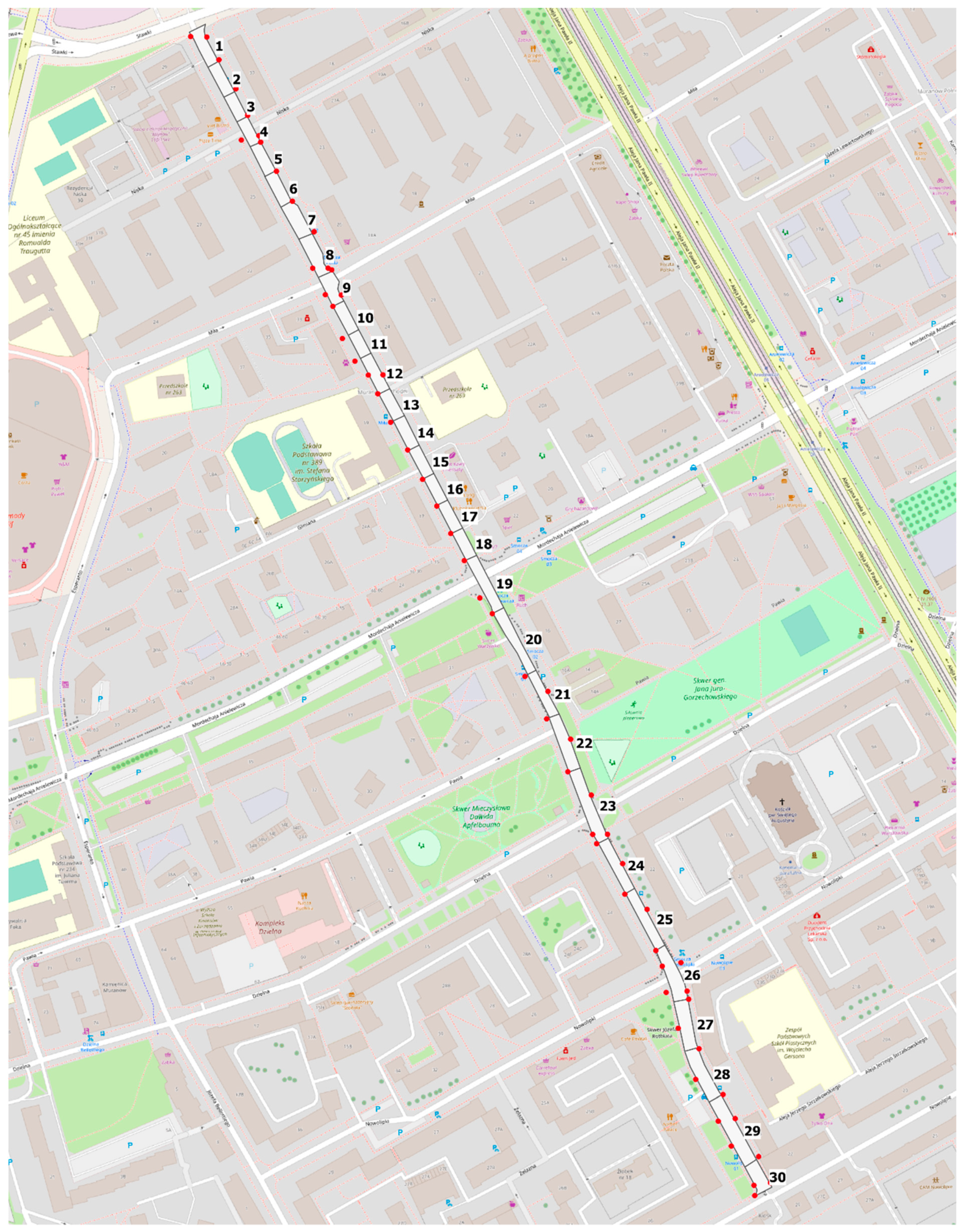
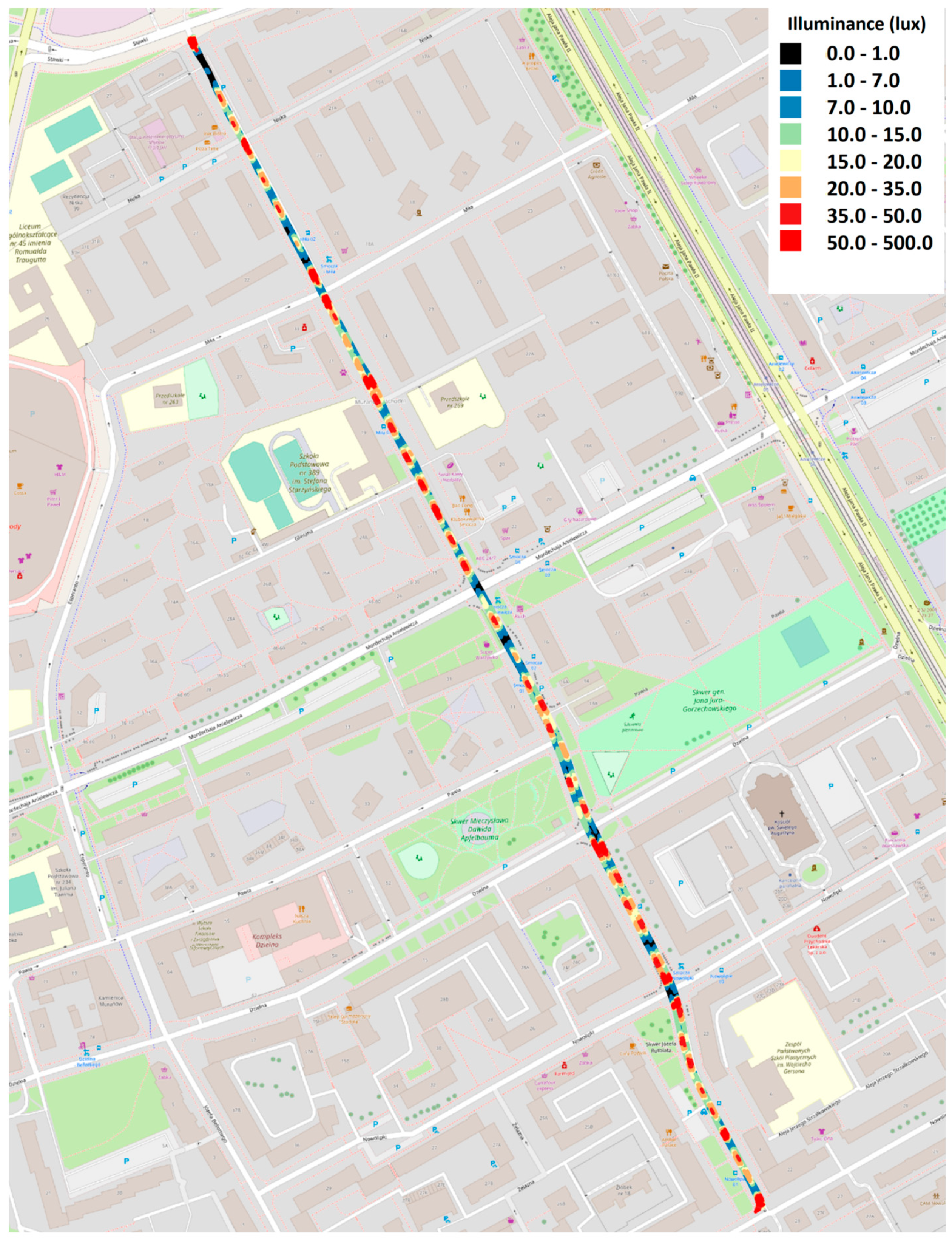
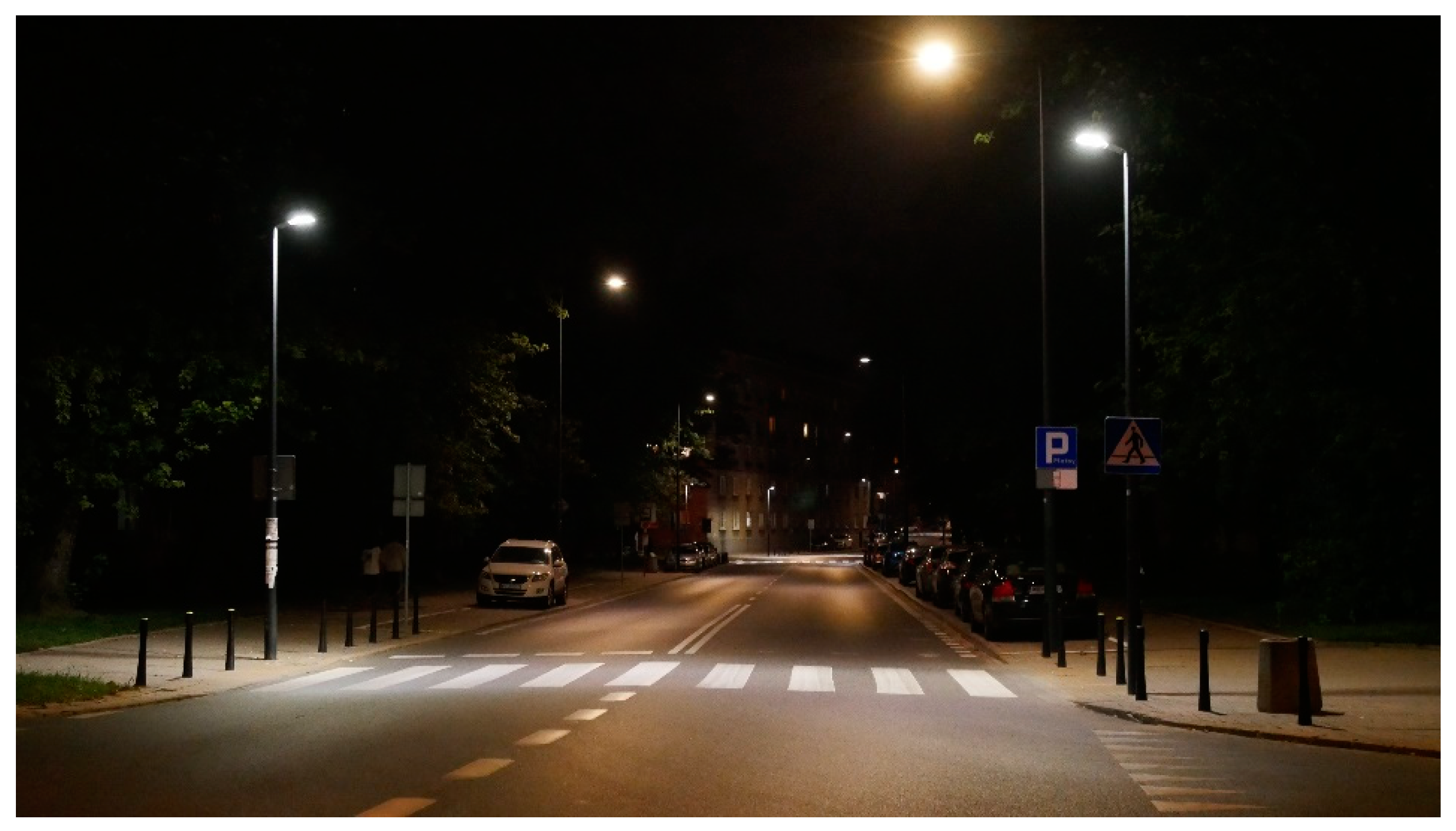
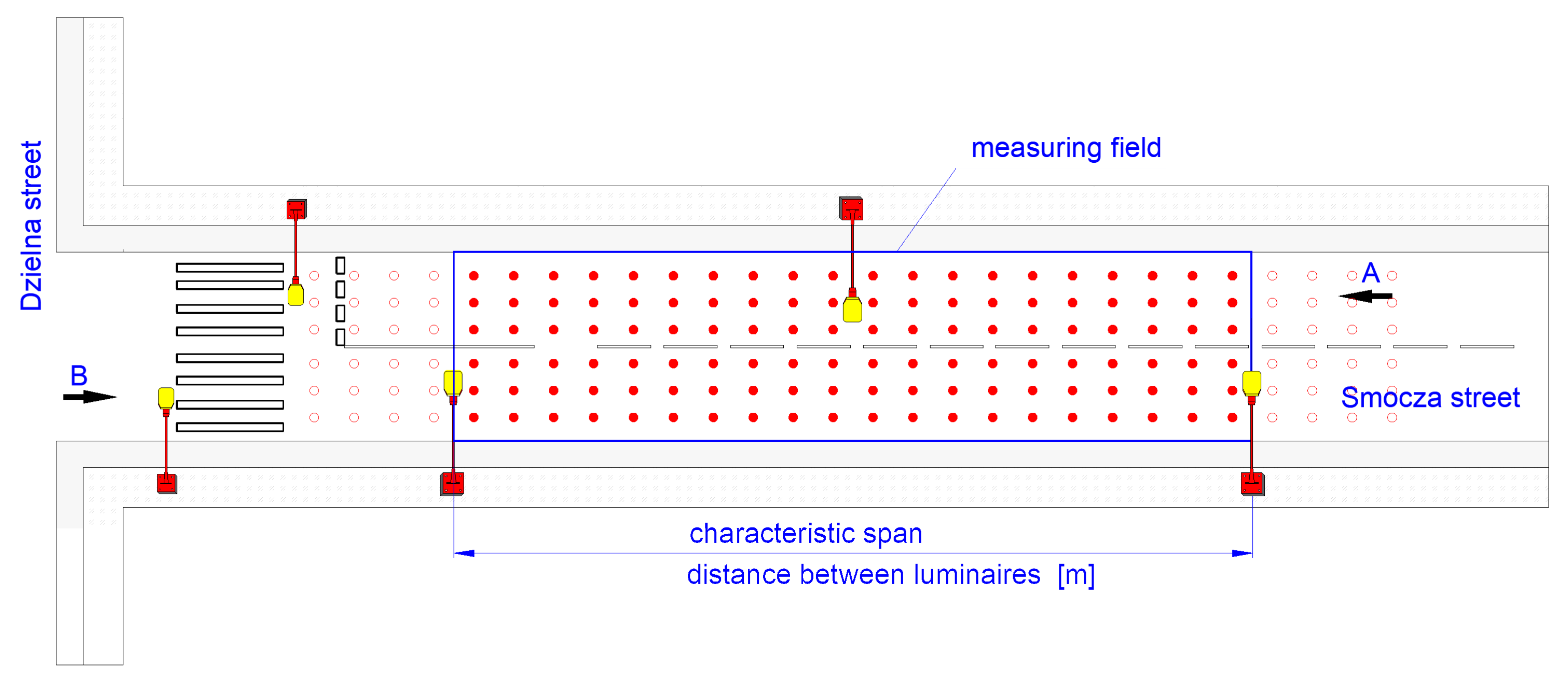

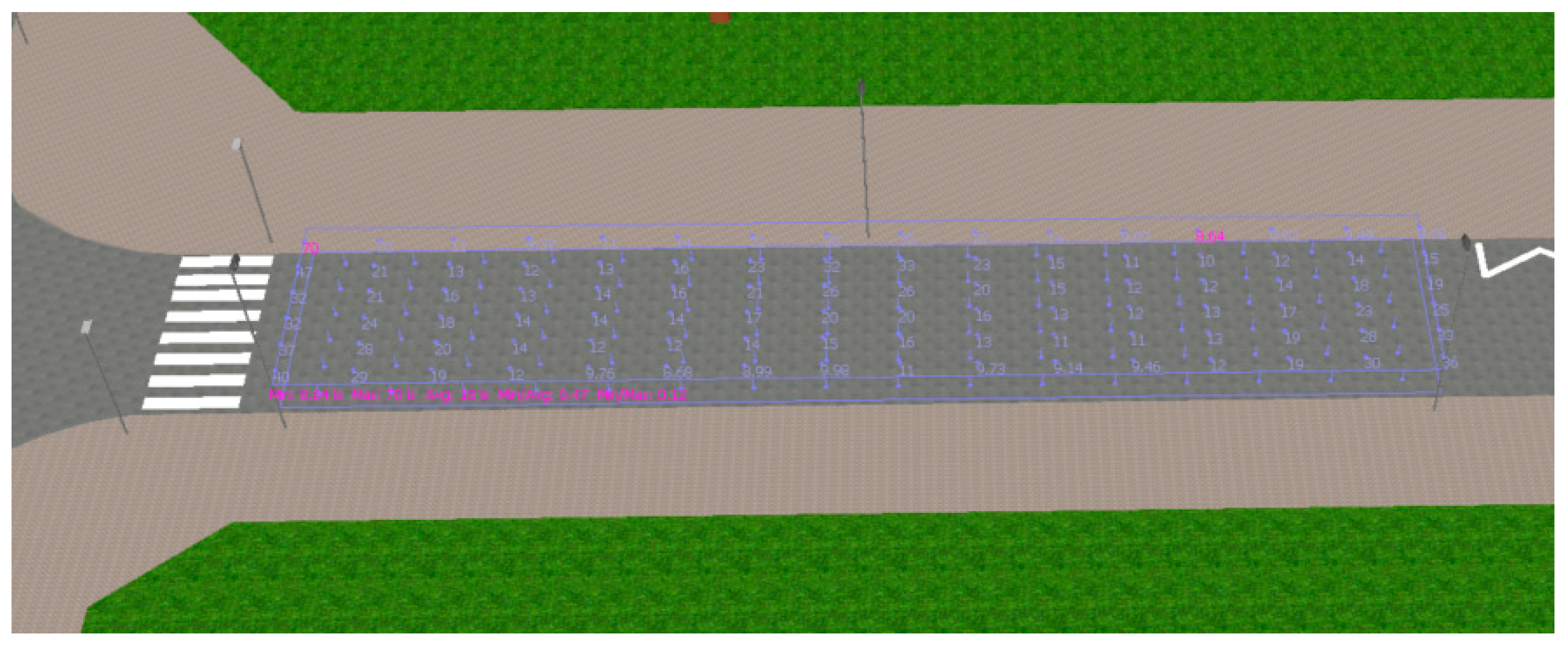
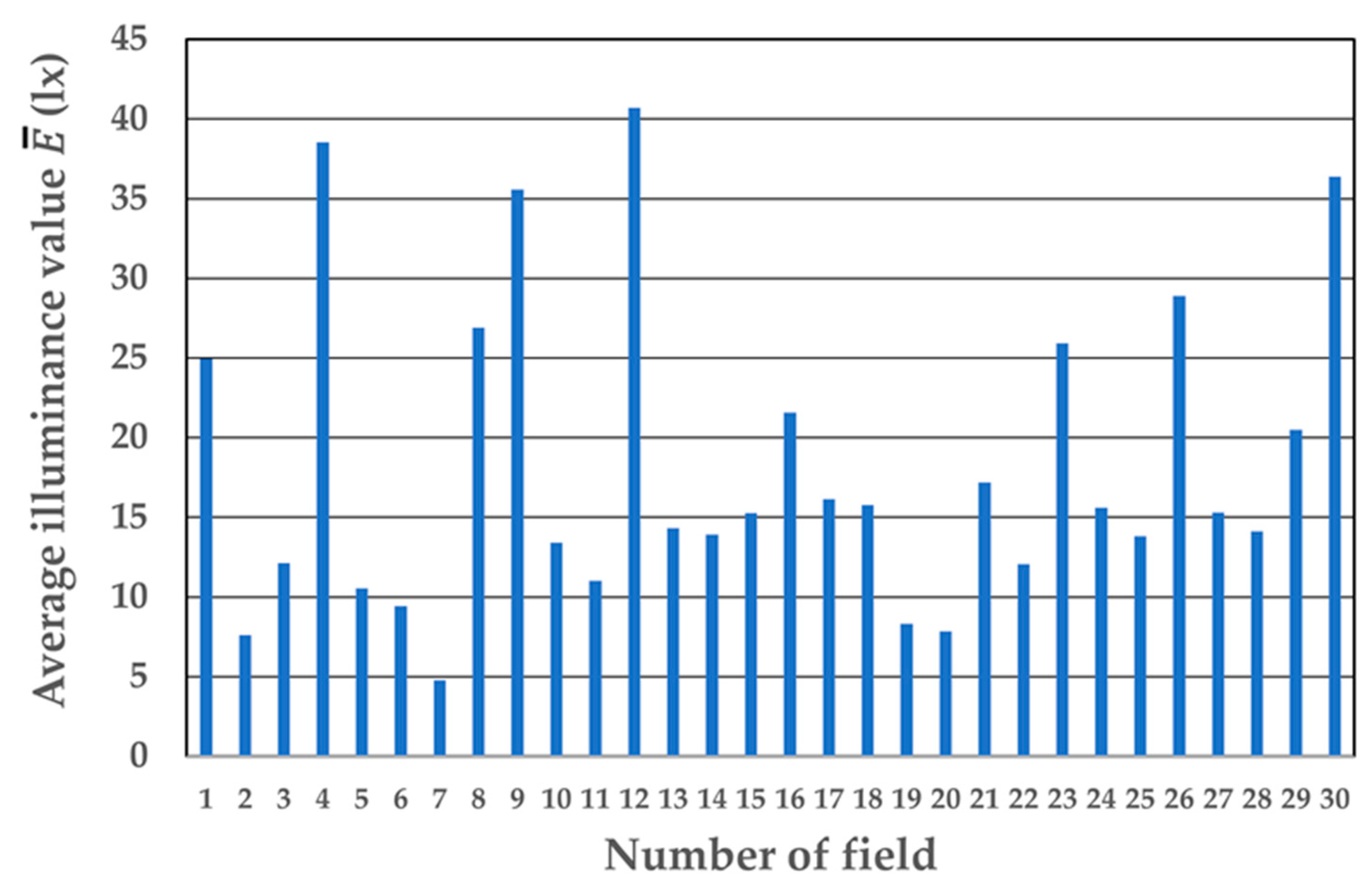
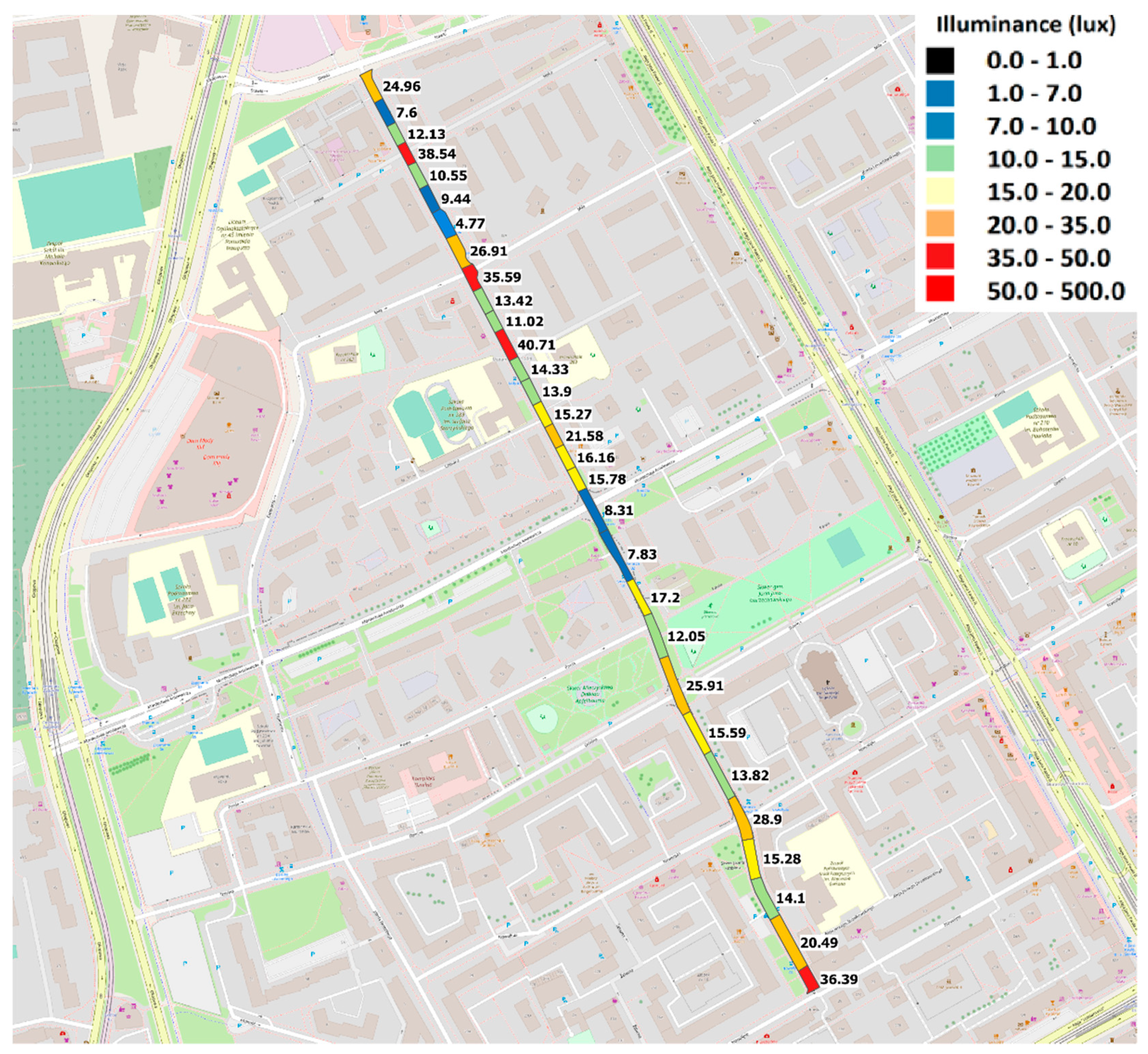
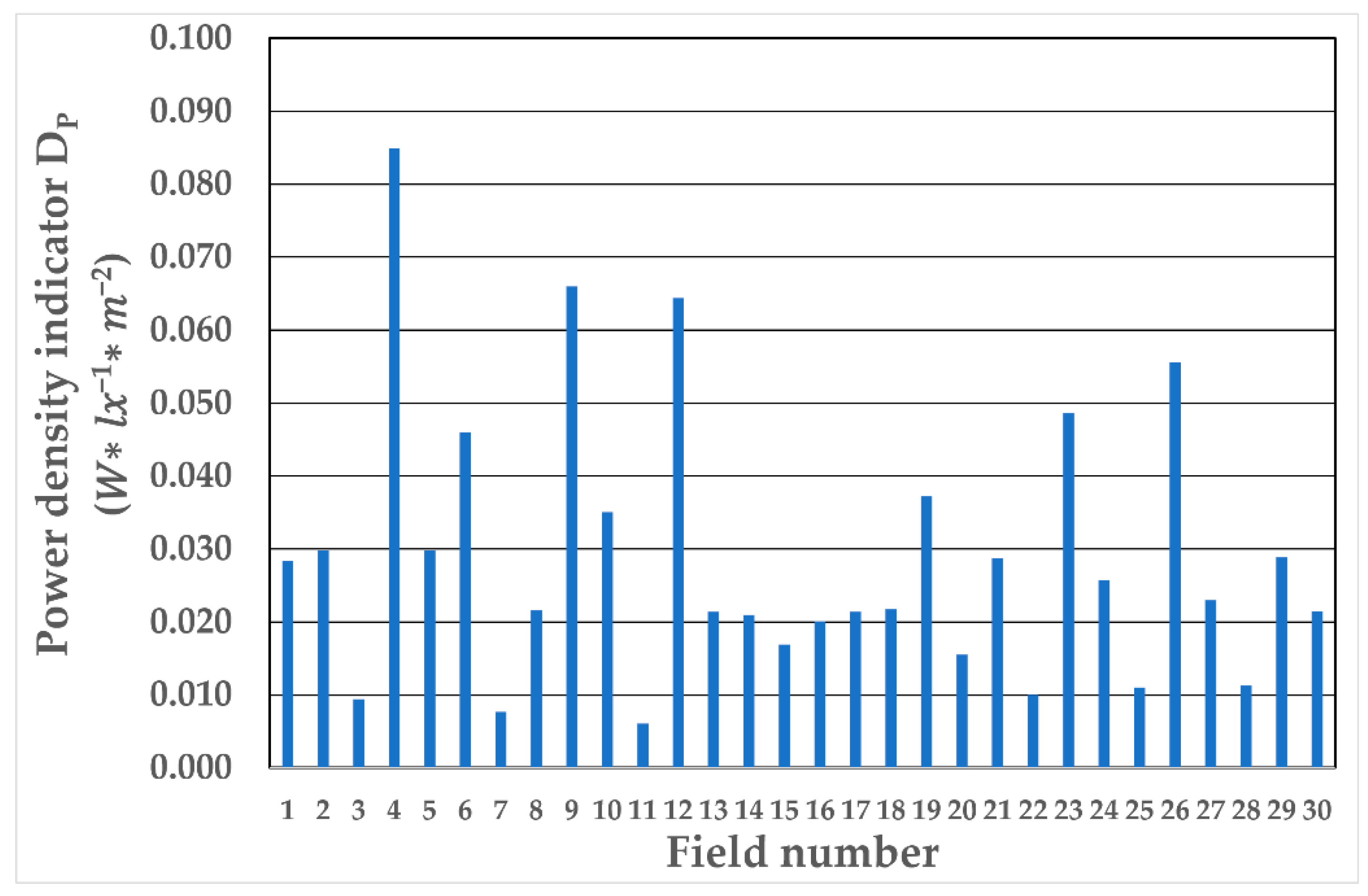
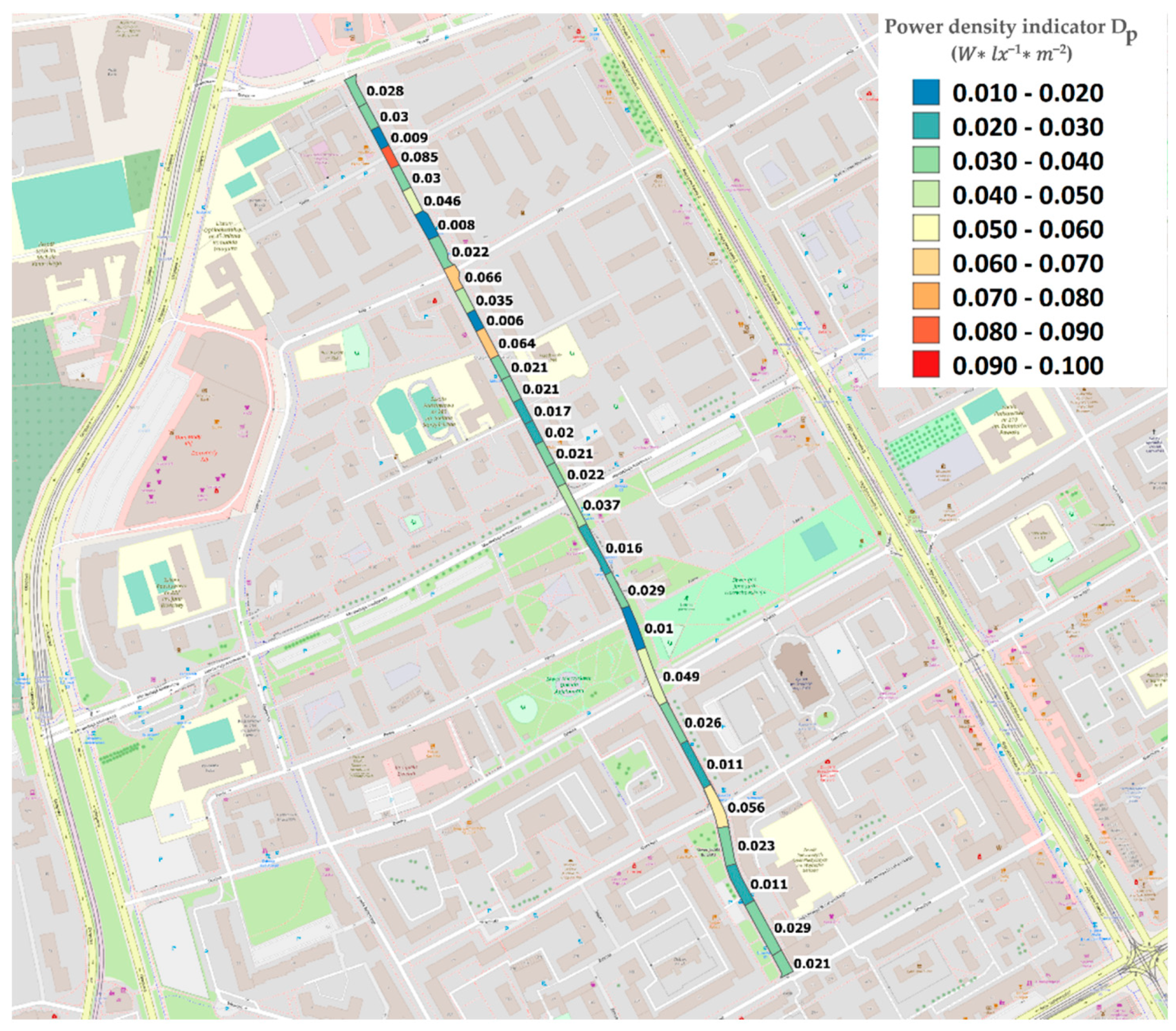
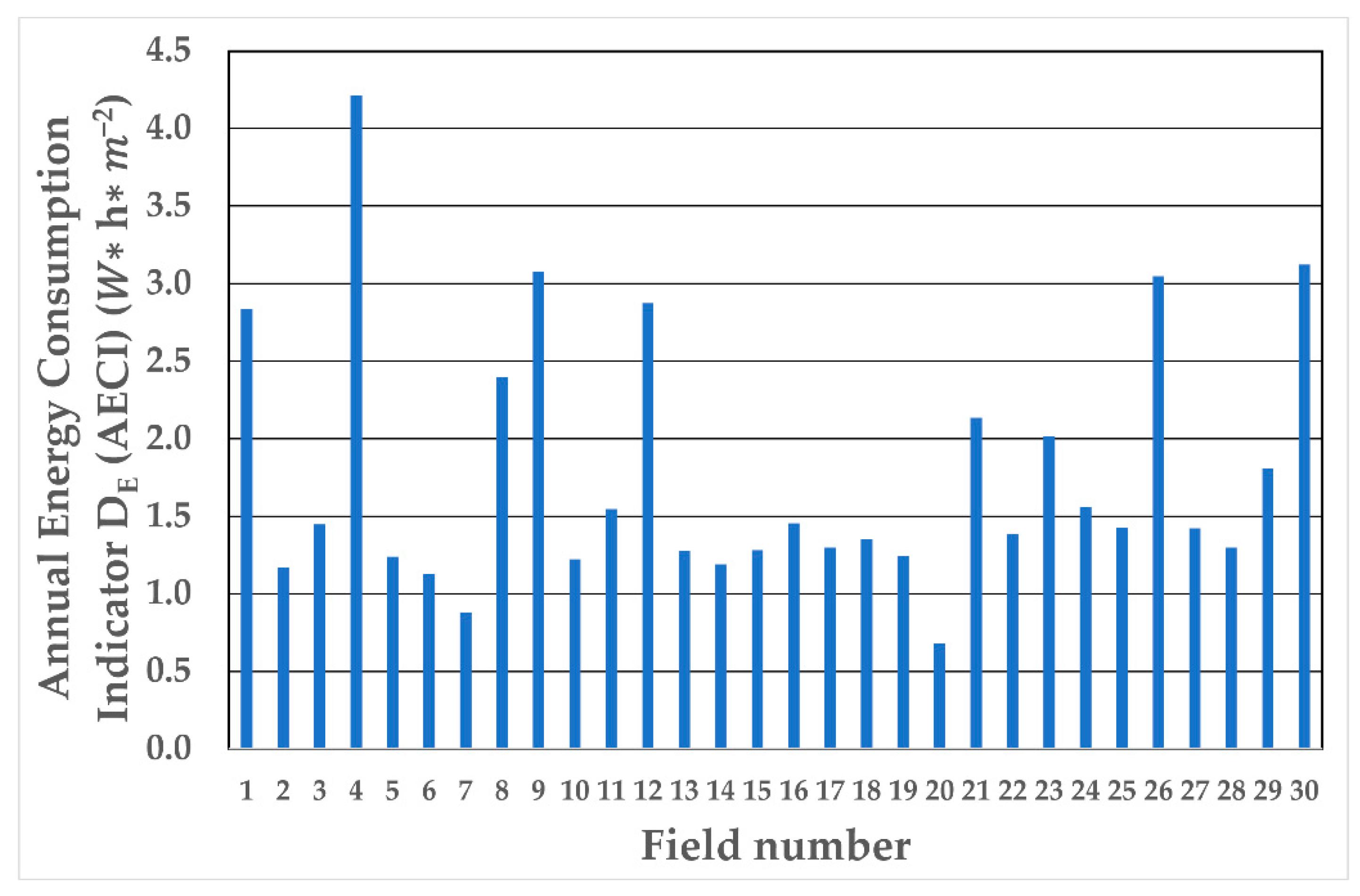
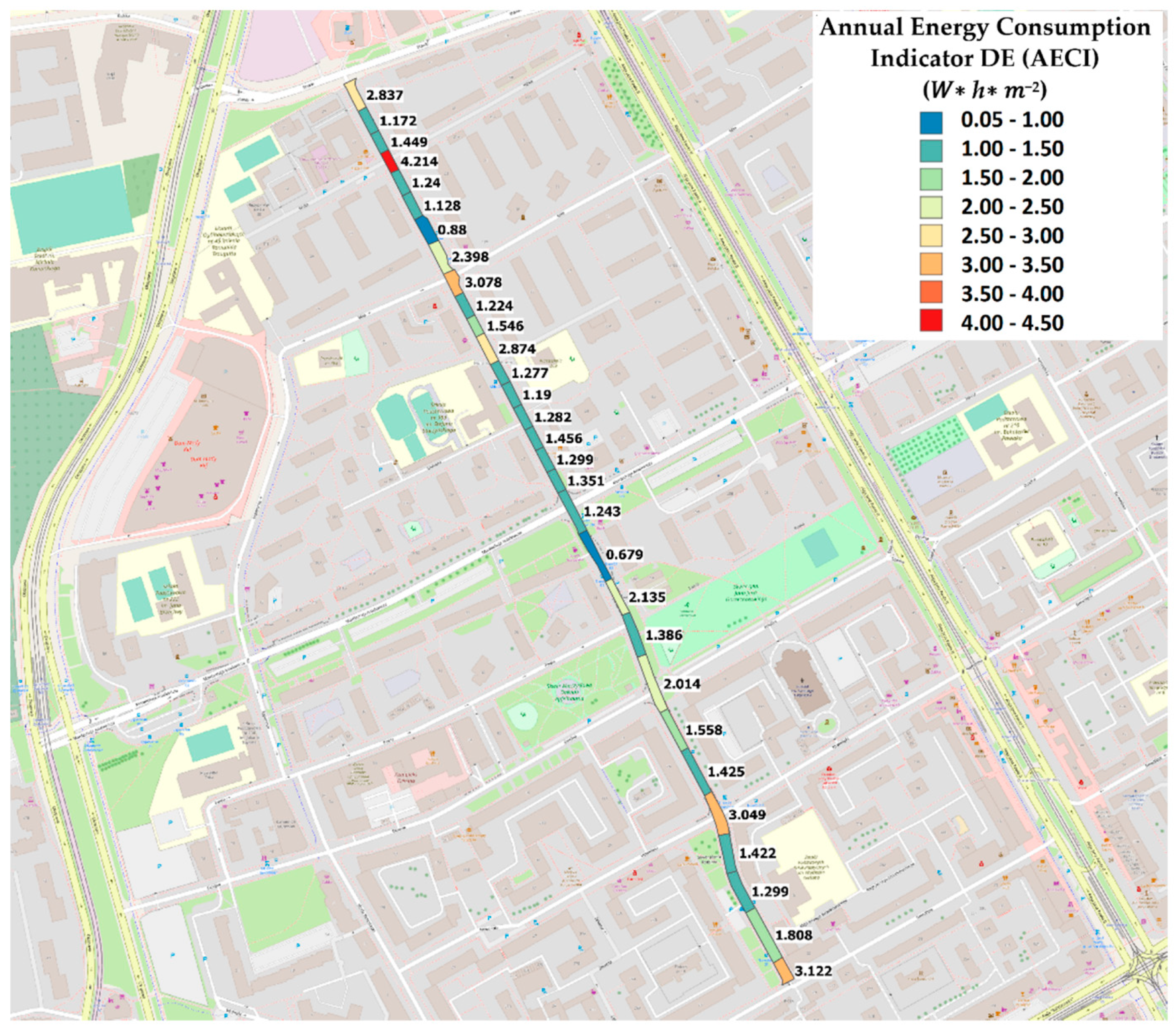
| Class | Horizontal Illuminance | |
|---|---|---|
| [lx] [Minimum] | Uo [Minimum] | |
| C0 | 50 | 0.4 |
| C1 | 30 | 0.4 |
| C2 | 20 | 0.4 |
| C3 | 15 | 0.4 |
| C4 | 10 | 0.4 |
| C5 | 7.5 | 0.4 |
| Direction B | Direction A | ||||
|---|---|---|---|---|---|
| 35.2 | 38.6 | 42.0 | 46.6 | 52.6 | 54.6 |
| 22.1 | 23.4 | 22.9 | 22.5 | 22.5 | 21.5 |
| 16.1 | 17.6 | 16.9 | 16.5 | 15.4 | 14.0 |
| 12.5 | 13.9 | 14.2 | 14.0 | 13.2 | 12.8 |
| 11.9 | 12.8 | 13.7 | 13.9 | 13.6 | 12.9 |
| 12.4 | 13.7 | 15.2 | 16.6 | 16.2 | 15.4 |
| 13.2 | 14.6 | 16.6 | 19.3 | 19.9 | 19.4 |
| 14.2 | 16.1 | 19.1 | 22.9 | 24.8 | 24.3 |
| 14.6 | 16.5 | 19.3 | 22.3 | 24.3 | 24.0 |
| 12.9 | 14.9 | 17.3 | 19.6 | 19.7 | 21.3 |
| 11.0 | 13.3 | 14.3 | 15.9 | 15.8 | 15.0 |
| 12.0 | 13.2 | 14.3 | 13.4 | 13.4 | 12.5 |
| 13.7 | 14.6 | 14.7 | 14.3 | 13.2 | 11.9 |
| 17.0 | 16.3 | 17.7 | 16.1 | 13.8 | 12.8 |
| 22.8 | 22.4 | 21.1 | 18.3 | 15.9 | 13.5 |
| 25.4 | 25.7 | 23.7 | 19.8 | 16.7 | 14.4 |
| Direction B | Direction A | ||||
|---|---|---|---|---|---|
| 36.2 | 39.5 | 38.5 | 42.8 | 56.7 | 69.5 |
| 28.2 | 22.1 | 21.5 | 18.0 | 17.2 | 15.5 |
| 19.7 | 21.6 | 22.1 | 19.4 | 18.0 | 14.3 |
| 14.2 | 15.4 | 16.3 | 15.9 | 14.9 | 10.0 |
| 12.7 | 15.1 | 15.9 | 16.1 | 15.2 | 12.8 |
| 13.2 | 16.4 | 18.6 | 20.9 | 21.0 | 18.9 |
| 13.1 | 18.0 | 20.2 | 25.8 | 26.8 | 25.4 |
| 10.2 | 21.0 | 24.8 | 33.3 | 38.0 | 38.0 |
| 15.4 | 21.0 | 28.1 | 34.4 | 38.4 | 19.3 |
| 13.9 | 17.4 | 20.3 | 23.9 | 25.7 | 25.3 |
| 13.1 | 16.4 | 17.5 | 20.0 | 20.2 | 18.5 |
| 13.5 | 15.8 | 17.0 | 17.4 | 16.2 | 14.1 |
| 15.2 | 17.9 | 18.1 | 17.5 | 15.6 | 12.2 |
| 22.8 | 25.0 | 24.4 | 21.6 | 18.0 | 13.6 |
| 31.2 | 31.7 | 28.4 | 23.7 | 20.1 | 15.9 |
| 40.2 | 39.8 | 34.7 | 26.2 | 23.0 | 17.6 |
| Field Number | (lx) | Uo | Area (m2) | Power (W) | ||
|---|---|---|---|---|---|---|
| 1 | 24.964 | 0.157 | 306 | 217 | 0.028 | 2.837 |
| 2 | 7.609 | 0.276 | 256 | 75 | 0.030 | 1.172 |
| 3 | 12.134 | 0.443 | 207 | 75 | 0.009 | 1.449 |
| 4 | 38.540 | 0.214 | 206 | 217 | 0.085 | 4.214 |
| 5 | 10.559 | 0.365 | 242 | 75 | 0.030 | 1.240 |
| 6 | 9.448 | 0.331 | 266 | 75 | 0.046 | 1.128 |
| 7 | 4.779 | 0.284 | 341 | 75 | 0.008 | 0.880 |
| 8 | 26.919 | 0.141 | 362 | 217 | 0.022 | 2.398 |
| 9 | 35.590 | 0.177 | 282 | 217 | 0.066 | 3.078 |
| 10 | 13.425 | 0.466 | 245 | 75 | 0.035 | 1.224 |
| 11 | 11.024 | 0.465 | 194 | 75 | 0.006 | 1.546 |
| 12 | 40.715 | 0.230 | 302 | 217 | 0.064 | 2.874 |
| 13 | 14.332 | 0.401 | 235 | 75 | 0.021 | 1.277 |
| 14 | 13.903 | 0.364 | 252 | 75 | 0.021 | 1.190 |
| 15 | 15.272 | 0.385 | 234 | 75 | 0.017 | 1.282 |
| 16 | 21.585 | 0.410 | 206 | 75 | 0.020 | 1.456 |
| 17 | 16.162 | 0.390 | 231 | 75 | 0.021 | 1.299 |
| 18 | 15.788 | 0.422 | 222 | 75 | 0.022 | 1.351 |
| 19 | 8.310 | 0.289 | 415 | 129 | 0.037 | 1.243 |
| 20 | 7.833 | 0.269 | 442 | 75 | 0.016 | 0.679 |
| 21 | 17.204 | 0.443 | 281 | 150 | 0.029 | 2.135 |
| 22 | 12.052 | 0.332 | 433 | 150 | 0.010 | 1.386 |
| 23 | 25.916 | 0.147 | 580 | 292 | 0.049 | 2.014 |
| 24 | 15.592 | 0.299 | 385 | 150 | 0.026 | 1.558 |
| 25 | 13.827 | 0.391 | 421 | 150 | 0.011 | 1.425 |
| 26 | 28.908 | 0.189 | 471 | 359 | 0.056 | 3.049 |
| 27 | 15.289 | 0.414 | 422 | 150 | 0.023 | 1.422 |
| 28 | 14.108 | 0.416 | 462 | 150 | 0.011 | 1.299 |
| 29 | 20.496 | 0.144 | 646 | 292 | 0.029 | 1.808 |
| 30 | 36.393 | 0.168 | 278 | 217 | 0.021 | 3.122 |
| Mean | 18.289 | 0.314 | 9825 | 4324 | 0.029 | 1.768 |
Publisher’s Note: MDPI stays neutral with regard to jurisdictional claims in published maps and institutional affiliations. |
© 2021 by the authors. Licensee MDPI, Basel, Switzerland. This article is an open access article distributed under the terms and conditions of the Creative Commons Attribution (CC BY) license (https://creativecommons.org/licenses/by/4.0/).
Share and Cite
Tomczuk, P.; Chrzanowicz, M.; Jaskowski, P.; Budzynski, M. Evaluation of Street Lighting Efficiency Using a Mobile Measurement System. Energies 2021, 14, 3872. https://doi.org/10.3390/en14133872
Tomczuk P, Chrzanowicz M, Jaskowski P, Budzynski M. Evaluation of Street Lighting Efficiency Using a Mobile Measurement System. Energies. 2021; 14(13):3872. https://doi.org/10.3390/en14133872
Chicago/Turabian StyleTomczuk, Piotr, Marcin Chrzanowicz, Piotr Jaskowski, and Marcin Budzynski. 2021. "Evaluation of Street Lighting Efficiency Using a Mobile Measurement System" Energies 14, no. 13: 3872. https://doi.org/10.3390/en14133872
APA StyleTomczuk, P., Chrzanowicz, M., Jaskowski, P., & Budzynski, M. (2021). Evaluation of Street Lighting Efficiency Using a Mobile Measurement System. Energies, 14(13), 3872. https://doi.org/10.3390/en14133872







